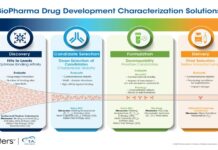Science and technology company Merck and XtalPi Inc., a pioneering pharmaceutical technology company powered by artificial intelligence (AI) and automation, have jointly published a study that highlights the benefits of combining computational workflows with wet lab experiments to advance drug development.
Traditional methods like milling and micronization, used to address undesirable crystal morphologies, can be disruptive and costly. In contrast, molecular dynamics simulations offer valuable insights for better crystallization experiment designs.
The collaboration between Merck and XtalPi focused on the impact of different polymer additives on the crystal habit of metformin HCl, a diabetes medication. By combining Merck’s experimental capabilities with XtalPi’s morphology prediction platform, a comprehensive screening approach for crystal morphology engineering was developed. XtalPi’s custom-made force fields successfully predicted the influence of polymer additives on metformin HCl’s crystal habits. The addition of HPMC led to a transformation from a needle-like to a prismatic morphology, in agreement with experimental observations. The publication demonstrates the potential of merging computational methods and experimental expertise for drug formulation optimization.
Dr. Peiyu Zhang, XtalPi’s Chief Scientific Officer, said, “By integrating XtalPi’s molecular dynamics predictions with Merck’s experimental validation, we have taken a step towards the rational engineering of desirable crystal habits. We hope to continue improving this ‘dry + wet lab’ method with leading industry experts like Merck, in the production of novel therapeutics worldwide.”
Dr. Jan Gerit Brandenburg, Head of Digital Chemistry at Merck, added, “Our collaboration with XtalPi is transforming pharmaceutical development. By seamlessly incorporating computer simulations with our experimental formulation expertise in a ‘digital-first’ approach, we are boosting drug development processes and positively impacting patients’ lives.”

















![Sirio Launches Global Research Institute for Longevity Studies [SIA]](https://www.worldpharmatoday.com/wp-content/uploads/2019/09/Sirio-218x150.jpg)

